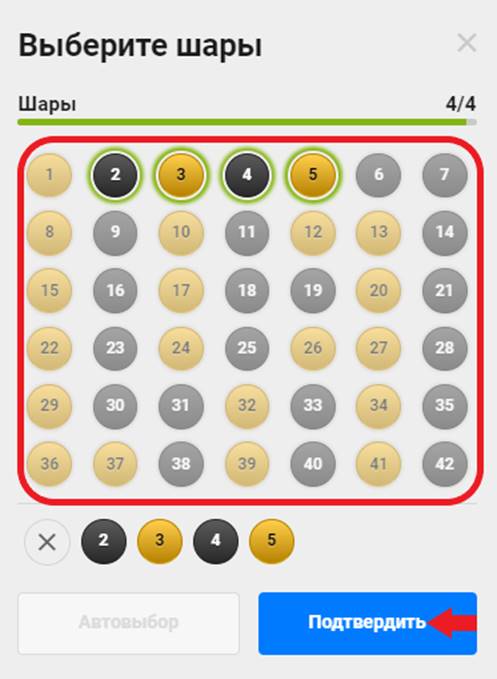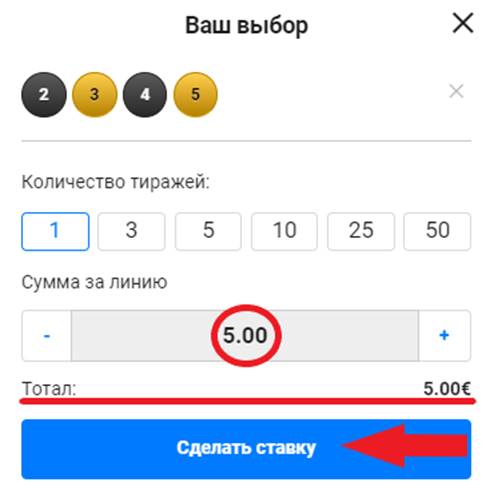Instant Lucky 7 is a dynamic non-live game based on a lottery, where the results are determined by a random number generator. Players are offered flexible betting options with different risk-reward ratios, where winning bets can bring profits that exceed the initial bet size by thousands of times.
Lucky 7 Game Process
Seven (7) winning balls out of forty-two (42) are randomly selected by the random number generator.
There is only one round of betting, and players can place bets by predicting the winning numbers; the more numbers predicted correctly, the higher the payout.
How to Place a Bet in Lucky 7
- Connect to your account;
- If necessary, top up your gaming account;
- Select a betting option;
- Click “Confirm” to proceed;


- Enter your bet amount in the “Amount” field in the Coupon;
- Click the “Place Bet” button.

- After the bet is placed, a message “Bet accepted” will appear.

How to Check Draw Results and Bet History
Each draw has a unique number, and its results can be found on the “Results” page.


You can check your bet history on the “Bet History” page.


Lucky 7 Game Rules
Terms:
1.1. RNG – random number generator used to randomly determine the winning balls after the betting round ends.
1.2. Balls – a set of forty-two (42) yellow and black balls used in the game. There are twenty-one (21) balls of each color, and the balls are numbered from one (1) to forty-two (42).
1.3. Payout Table – a table presenting coefficients based on how many numbers the user selected and how many of them matched the winning numbers.
1.4. Coefficients – numerical expression determined by the game organizer, which is multiplied by the player’s bet amount to calculate the winnings.
1.5. Betting Round – a period of time starting from the announcement (accompanied by a countdown timer) allowing users to place bets and ending with the announcement that no more bets can be placed.
Rules:
2.1. Seven (7) winning balls out of forty-two (42) are randomly selected by the RNG engine after the betting round ends.
2.2. The draw is considered successful if seven (7) balls are selected as winning balls. In other cases, the draw is considered void, and all bets are returned.
Gameplay:
3.1. There is only one round of betting, during which users can select the numbers of balls they believe will be drawn as winning numbers in the upcoming draw. Users can choose how many balls they want to select from the offered betting options.
3.1.1. A betting round precedes the game draw. As soon as the current betting round ends, the betting round for the upcoming draw begins immediately.
3.2. The chances of winning are determined by the number of balls chosen by the user and the number of correctly predicted balls. The higher the number of correctly predicted balls, the higher the potential income. The game interface provides users with a payout table.
Betting Limits:
4.1. Maximum and minimum betting limits are determined by the gaming establishment.
Error Handling:
5.1. Canceled draws.
5.1.1. Draws may be canceled due to technical glitches such as internet connection issues or server failures;
5.2. If a player cannot view the draw results for technical reasons on their side (no internet connection, power outage, etc.), but the draw result can be found in the archive, it is considered that the draw took place.
5.3. In case of a canceled draw, all bets are declared void, and bets are returned to users (coefficients are equated to one).
Game Organization Procedure:
6.1. The game operates 24 hours a day, 7 days a week, with breaks for technical maintenance as needed.
Additional Information:
7.1. These rules and provisions are published in multiple languages for informational purposes and to facilitate player access. However, the legal basis for relations between the player and the operator is solely the English version. In case of any discrepancies between the non-English and English versions of these rules and provisions, the English version takes precedence.
7.2. Any player claims regarding draw results or other technical issues must be directed to the operator no later than thirty (30) days after the relevant draw.